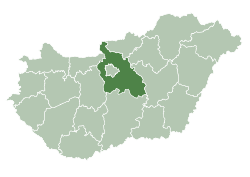Budakeszi
| Budakeszi | ||
|---|---|---|
|
Aerial view | ||
| ||
 Budakeszi Location of Budakeszi | ||
| Coordinates: 47°30′44″N 18°55′41″E / 47.51227°N 18.92806°ECoordinates: 47°30′44″N 18°55′41″E / 47.51227°N 18.92806°E | ||
| Country |
| |
| County | Pest | |
| Area | ||
| • Total | 37.11 km2 (14.33 sq mi) | |
| Population (2007) | ||
| • Total | 13,590 | |
| • Density | 351.46/km2 (910.3/sq mi) | |
| Time zone | CET (UTC+1) | |
| • Summer (DST) | CEST (UTC+2) | |
| Postal code | 2092 | |
| Area code(s) | 23 | |
Budakeszi (German: Wudigeß) is a town in Pest County, in the Budapest metropolitan area, Hungary. It is located beyond the Jánoshegy hill at the western city limits of Budapest, about 12 km (7 mi) west of the Zero Kilometre Stone in the city centre. A popular recreational area, the landscape is characterized by extended forests, predominantly oaks, by vineyards and orchards.
Meaning of the name
Buda is the western side of Budapest, Keszi was one of the seven ancient Hungarian tribes.
History
The settlement in the Kingdom of Hungary was first mentioned about 1270, it was completely devastated during the Ottoman Siege of Buda in 1541. In the aftermath of the Ottoman defeat at the 1683 Battle of Vienna, the depopulated area was re-settled with "Danube Swabian" (most of them actually descending from Lorraine, the Palatinate and Alsace) immigrants by the order of the Habsburg King Leopold I. Budakeszi was for centuries a predominantly "Schwabian" (ethnic German) village.
After World War II Budakeszi's history was greatly influenced by the deportation of its ethnic German population according to Article 12 of the 1945 Potsdam Agreement. Though the expulsion was ordered under pressure of the Soviet forces, many Hungarians relished in the humiliation of ethnic Germans throughout the region and collectively took part in organized, forced deportations of German-speaking citizens to Germany proper. Most of these expellees had never been to Germany before, as even their great-grand parents had been born in Hungary. Budakeszi lost a great number of its citizens due to the above and the vacuum was later filled with the settlement of families from other regions, such as Transylvania.
Budakeszi today
Most of its inhabitants commute to work to the capital Budapest daily. With mass transportation (No. 22 bus or Volánbusz intercity bus) this normally takes about 15 minutes.
Although Budakeszi is a town, it still looks nothing more than a charming and picturesque village with a historic main street and a quaint baroque Roman Catholic church in its valley. There is also a lovely Protestant church worth visiting, its cemetery has largely German-named headstones, some of which date back to the early 19th century. (There are also about a dozen WW2 Polish soldiers buried in the cemetery, their graves are nicely maintained by their brethren Hungarians).
Today Budakeszi's population is mixed; Hungarians, Schwabian-Germans, Transylvanians all of whom share this small town and live in harmony. The surrounding hills are ideal for tourists. Near Budakeszi there is an airfield for sailplanes (gliders) and for small planes, as well as a recently established World War 2 German military cemetery.
International relations
Twin towns — Sister cities
Budakeszi is twinned with:
| City | Country | Year |
|---|---|---|
| Delbrück-Westenholz | |
|
| Deyda | |
|
| Lich | |
|
| Neckarsulm | |
|
| Snakt Margarethen an Raab | |
|
| Toplița | |
Notable citizens
Among the ethnic Germans expelled from Budakeszi in 1946 were the parents of Joseph "Joschka" Fischer, born in 1948, German foreign minister from 1998-2005. Fischer today holds an honorary citizenship.
- András Balczó, Olympic gold medalist (Modern Pentathlon, 1972)
- Gáspár Nagy, poet, Kossuth Prize winner
- Zsolt Vajda, Media artist
- Csaba Pléh, psychologist, linguist, Széchenyi Prize winner
External links
| Wikimedia Commons has media related to Budakeszi. |
| Wikivoyage has a travel guide for Budakeszi. |


